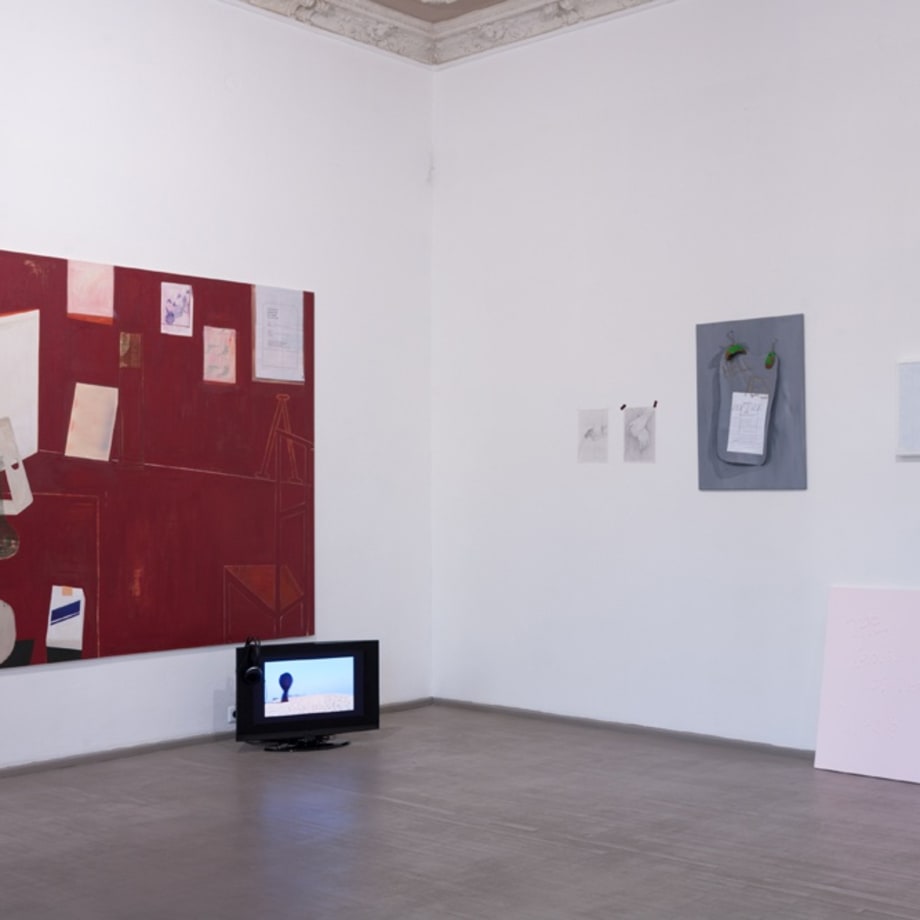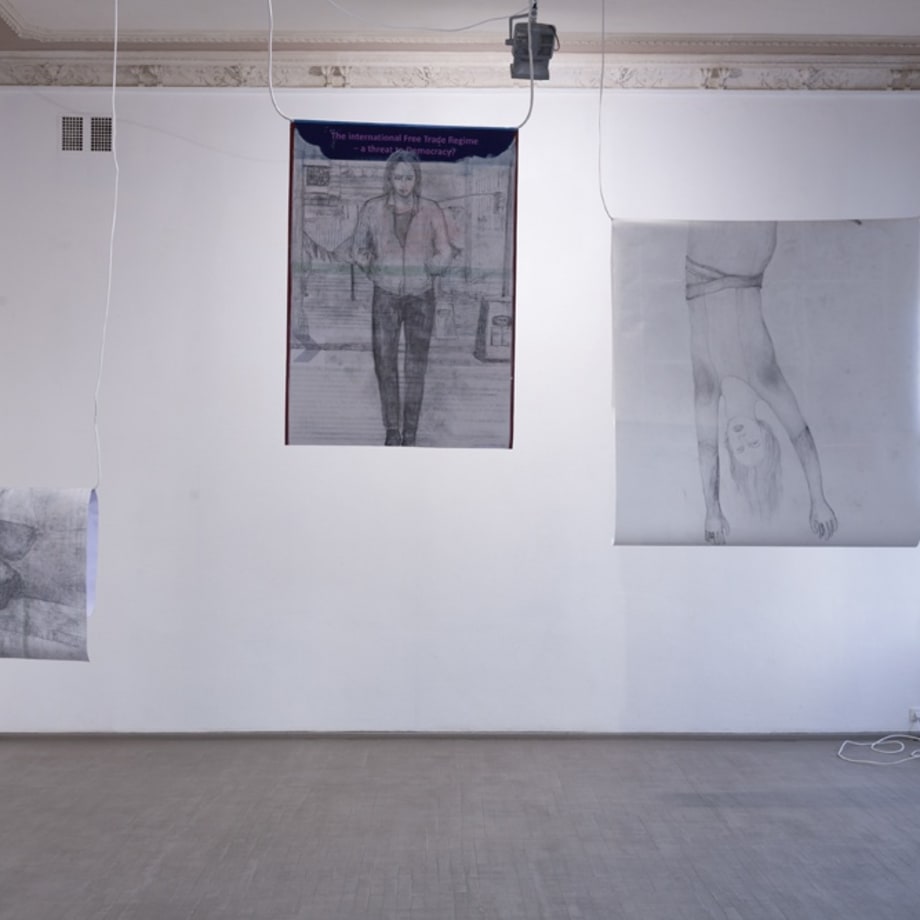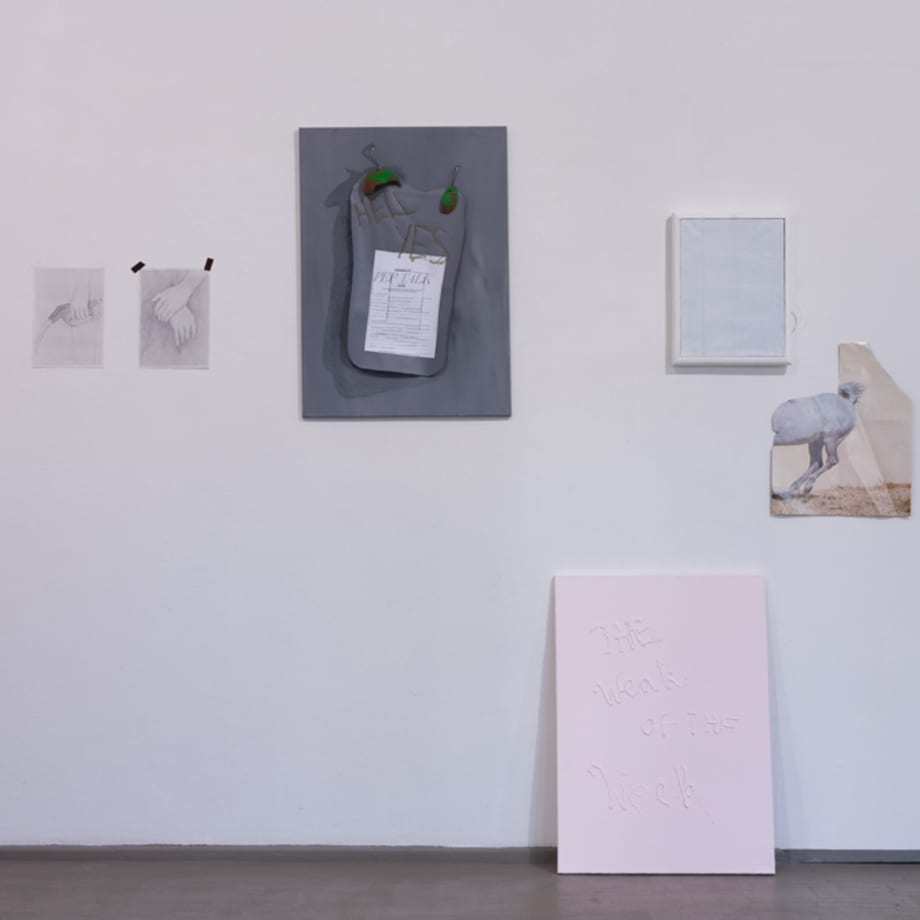DER CHAMPAGNERKÄFIG : Group exhibition
Artists:
Adrian Buschmann
Anne Cathrin Ulikowski
Dörte Oppermann
Lilli Thießen
Dear Artists,
These works are on fire. They are like blocks that make up sentences that are used to tell this story of ours: Der Champagnerkäfig. It isn’t just a cage but also an incoherent sequence of occurrences, snaking their way along the margins of their confinement, through and around its bars. These ghosts dangle. They snap and they hang dizzily. They are seen and they hurt. After ten or a hundred years, and a myriad of events: We come together on this occasion. The four of us, sipping from this bottle.
Looked at Matisse’s house in Nice and tried to find his white tape in San Remo. This idyll is askew, its home is in a riot of flowers by the sea. This crisis is crumbling, palm trees stand beheaded. It is a serene quiescence, no escapism. Some of these thoughts turn out to be more clear than others.
Remembering what has to be shipped. Empty bags, full of it. A quarter past midnight, a message arrives from a hill in Vallebona: Seeing TIME in its undies that reach the tummy button. Enjoying the whole range of colors. We’re sticking bags on windows, as if people wouldn’t hang curtains or blinds over these Zeitfenster but instead would just cover them against the mess and light. A milky, plastic calm.
In the gallery they are instituted like traps and the sun shines in Italy. In France, approximately nine years ago, videos with dresses made out of plastic bags were shot. Sometimes there is a comicbookmood governing this world. Charged, carried along and worn, and tragic super heroes drawn on data of social economics. Heroines with neither overtures nor champagne are hanging from the ceiling. Will any network catch them? Do we all want to go all out?
A lot gets mixed up and works like x-ray, scanning our pose. The champagne has flown. Another message arrives: You’re only portraying yourself, said my fellow student. I lied and said, all artists do. And also, this isn’t me. Maybe it shows how I want to be, but how anyways? These are just stills of a story that you have to imagine yourself.
Sincerely
Patron
Vilnius City Municipality
Exhibition sponsored by
Lithuanian Council for Culture, BMUKK
Gallery sponsored by
Lietuvos rytas daily, Ekskomisarų biuras Security Services, city-info.net
Special thanks to
Romas Kinka
On 8 September, the exhibition Der Champagnerkäfig (The Champagne Cage) opens at Galerija VARTAI. The participating artists share an approach, at the same time both critical and dreamlike, to the phenomena of the contemporary art market, the status of the artist, identity, career development and the stereotypes connected with these subjects.
The vibrant and dynamic contemporary art milieu prompts artists to form interest groups. Often these bring together artists who are concerned with similar issues and standpoints. This group of artist has come together as a result of collaborating over the last ten years over which period their paths have crossed in many different ways - be it family, work or friendship.
The work presented in the exhibition seeks to seduce the viewers and bewitch them. The artists' goal is to make sense of and define their identity in a concrete situation, to make use of history and contemporary art trends, and crystallize the unavoidable probability of paradoxes and deal with them both in their creative work and everyday lives.
Dear Artists,
These works are on fire. They are like blocks that make up sentences that are used to tell this story of ours: Der Champagnerkäfig. It isn’t just a cage but also an incoherent sequence of occurrences, snaking their way along the margins of their confinement, through and around its bars. These ghosts dangle. They snap and they hang dizzily. They are seen and they hurt. After ten or a hundred years, and a myriad of events: We come together on this occasion. The four of us, sipping from this bottle.
Looked at Matisse’s house in Nice and tried to find his white tape in San Remo. This idyll is askew, its home is in a riot of flowers by the sea. This crisis is crumbling, palm trees stand beheaded. It is a serene quiescence, no escapism. Some of these thoughts turn out to be more clear than others.
Remembering what has to be shipped. Empty bags, full of it. A quarter past midnight, a message arrives from a hill in Vallebona: Seeing TIME in its undies that reach the tummy button. Enjoying the whole range of colors. We’re sticking bags on windows, as if people wouldn’t hang curtains or blinds over these Zeitfenster but instead would just cover them against the mess and light. A milky, plastic calm.
In the gallery they are instituted like traps and the sun shines in Italy. In France, approximately nine years ago, videos with dresses made out of plastic bags were shot. Sometimes there is a comicbookmood governing this world. Charged, carried along and worn, and tragic super heroes drawn on data of social economics. Heroines with neither overtures nor champagne are hanging from the ceiling. Will any network catch them? Do we all want to go all out?
A lot gets mixed up and works like x-ray, scanning our pose. The champagne has flown. Another message arrives: You’re only portraying yourself, said my fellow student. I lied and said, all artists do. And also, this isn’t me. Maybe it shows how I want to be, but how anyways? These are just stills of a story that you have to imagine yourself.
Sincerely
Adrian Buschmann (b. 1976, Poland) graduated from the Berlin University of the Arts. In 2013 he received the STRABAG Artaward International for his work. Buschmann’s painting oscillates between abstraction and emotional visuality, combines stylistic elements from various periods, and ironically reflects on the contemporary art scene. His seemingly ephemeral paintings pulsate with boldness and assurance.
Anne Cathrin Ulikowski (b. 1980, Germany) studied at the Berlin University of the Arts and the University of Hamburg. The artist combines abstract painting with figures of cartoon characters and famous people. She is looking for exceptional moments in everyday existence that emerge like cinematic freeze frames. Her work is often political, and focuses on women’s status in society and contemporary art. She is currently studying for her Master's degree in social economics.
Dörte Oppermann (b. 1942, Germany) studied graphic art at the Academy of Fine Arts in Hamburg and later taught at the University of Wuppertal. Her work practice embraces performance, photography, drawing, sculpture and video art. She is meticulous in choosing her subjects which she then analyses as to their impact on perception and translation. She has been living and working in both France and Germany for many years.
Lilli Thießen (b. 1983, Germany) graduated from the Vienna Academy of Fine Arts in 2010. Using the collage technique or in her latest works painting with her fingers, the artist imitates digital movements typical of today's widely used touchscreens. Her installation, collage and painting work may at first glance seem ironic but is in fact deeply serious. She aims to use elements of pop culture and appropriate advertising strategies for a social critique of consumer culture.












